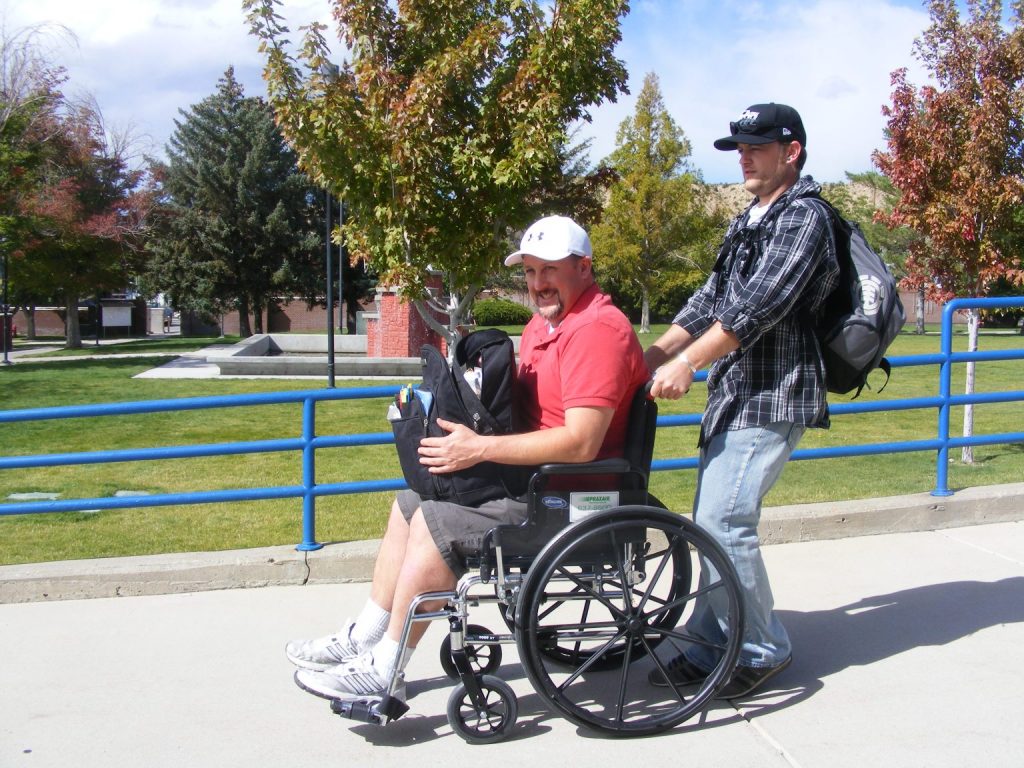Nursing students experience being in a wheel chair for an hour
can go across campus in a few minutes to get to class. We go to the restroom with relative ease. We are able to overlook numerous problems, many that would never even come to mind.
The nursing 1030 class was given an assignment that would open their eyes to some of these obstacles. The assignment being to spend one hour in a wheelchair, during which they were required to go shopping, use an elevator, go over a curb, sit at a table, use the water fountain, go to the restroom, and spend 15 minutes wheeling themselves.

This archived article was written by: Tadd Mecham
can go across campus in a few minutes to get to class. We go to the restroom with relative ease. We are able to overlook numerous problems, many that would never even come to mind.
The nursing 1030 class was given an assignment that would open their eyes to some of these obstacles. The assignment being to spend one hour in a wheelchair, during which they were required to go shopping, use an elevator, go over a curb, sit at a table, use the water fountain, go to the restroom, and spend 15 minutes wheeling themselves.
Put into groups of two, each pair took a turn spending one hour in the wheelchair, the other person helping them around campus. Student Jaime Auger found the restrooms to be a difficulty in themselves saying, “there is a handicapped stall, but getting to it is so narrow you have to go in one way because you can’t turn around in the stall. You have to back down the hallway to get into it.”
There were also more subtle things that many people may not realize presents a problem. The inclined walkways around campus present a challenge. Auger said that “while wheeling yourself up an incline, even a small one, your arms are mush in 10 minutes.” Other sidewalk problems are the curbs, particularly the ones by major cross walks on campus. The cement takes such a sharp dip that wheelchairs became easily stuck, blocking traffic and giving those in the wheelchairs an even more trying time getting around campus.
The students found the cafeteria staff to be very helpful and accommodating to their needs, but once reaching tables to eat, more newfound problems were discovered. Tumu Asuao said, “I had to adjust my seated position several times to find a comfortable place. The tables were too low for the chair to tuck underneath so I had to lean forward to reach my food. If there were higher tables it would have made it easier to eat my meal.”
Miranda Gold commented on the cafeteria experience, “It was harder to reach everything. The space I sat in also had to be wide enough for the wheelchair to fit. If everything needed to eat was not all gathered first, it was tiring to have to wheel back to grab anything else.”
One of the most noticeable things to participating students turned out to be the looks and treatment given to them by fellow students. While student Daniel Quick found that students “weren’t that obvious about staring,” Gold found it funny how people would either stare or be extra friendly to her for no reason. Many people, according to Auger, would just avoid eye contact all together.
This assignment helped students to look at life from a different perspective. Through one hour of being in someone else’s shoes (or seat) their entire perspective and respect for those with disabilities were changed
Among all of these obstacles one thing was noticed: someone would always appear to offer a helping hand. There are many people that are willing to help those handicapped on campus. We are all the same; we just get around a little different.




